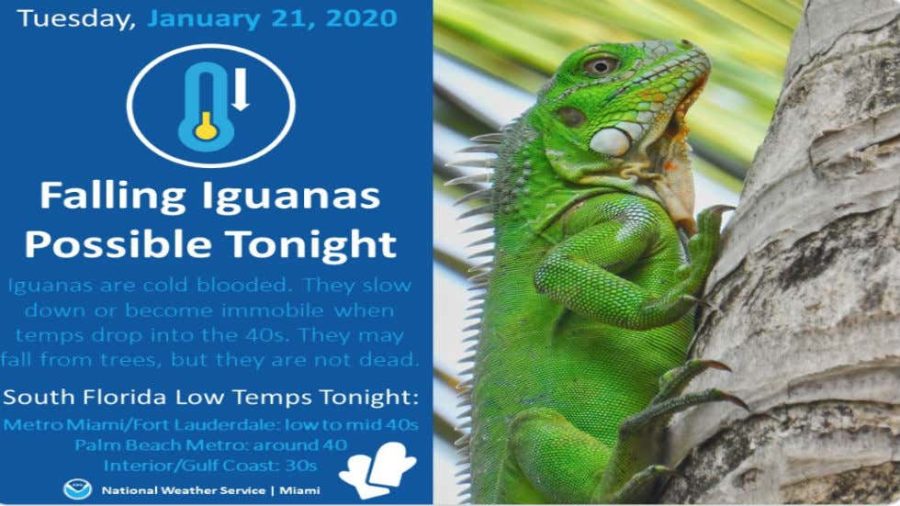Iguanas Raining Down
February 22, 2022
Iguanas raining from the skies is quite the odd weather condition, but due to cold swings in various parts of Florida, it is becoming more common. On various social media platforms such as Instagram and Facebook, Iguanas can be seen sprawled out on the ground due to these cold snaps. According to USA Today, this is a new “social media phenomenon that meteorologists, the Weather Channel, Accuweather, and the National Weather Service like to reference,” but there is a reason for this new weather phenomenon and certain actions that should be taken.
Iguanas, being reptiles, are ectotherms. According to Mic.com, Ectotherms, such as the green iguana, rely on external conditions to regulate their body temperatures. This means basking on a rock in the sun to warm their bodies or hiding out in the shade when they are overheating. Due to being ectotherms, when the Iguanas are faced with cooler temperatures, around 30 to 40 degrees Fahrenheit, their bodies begin to malfunction. The Iguanas bodies cool to such an extent that metabolic processes slow causing decreased energy and strength. When the iguanas reach this critical point, they end up losing their grip on tree branches and other structures and then falling. These fallen iguanas end up sprawled on the ground for an hour or two, but once it warms up, their metabolic processes speed up and they can move again. However, if it remains too cold for too long, the iguanas could end up dying due to their slowed metabolism. According to Khan Academy, Unlike ectotherms, humans and other mammals are endotherms that regulate their temperature internally through efficient metabolic processes and other various adaptations. This is why we do not slow down and freeze up when we become too cold.
During these cold snaps, the Florida Fish and Wildlife Conservation Commission “encourages the removal of green iguanas from private properties by landowners.” Iguanas are an invasive species to Florida that appeared in the 1960s and threaten the balance of native wildlife. According to the Florida Fish and Wildlife Conservation Commission, green iguanas eat endangered species and take up resources the native species need, harming the natural ecosystem. On top of harming the wildlife, iguanas destroy gardens, dig up sidewalks, and leave feces everywhere. Iguanas, being invasive species, are incredibly harmful to the environment of Florida. Most reptiles in Florida can survive these cold snaps due to a variety of adaptations that the iguanas lack, because the iguanas originate from Caribbean islands and some parts of Central America where the temperatures are consistently much warmer. According to Mic.com, most officials urge residents to humanely kill green iguanas if possible due to the harm they cause.
Iguanas have not been the only victims of the cold snaps in Florida. According to eurogreen.com, many crops and marine organisms have also been suffering from these cold snaps and end up worse off than the iguanas. Florida is a big exporter of many fruits and vegetables due to its climate, but these cold snaps have caused the death of vegetation all over the state. Citrus trees end up dropping off their fruit due to the cold and strawberry, bell pepper, bean, corn, lettuce, and cabbage plants can all die due to these cold snaps. These temperature changes also harm organisms like manatees and turtles that live off the coast. This issue is a lot more prominent than the iguanas due to them being native species and not invasive.

